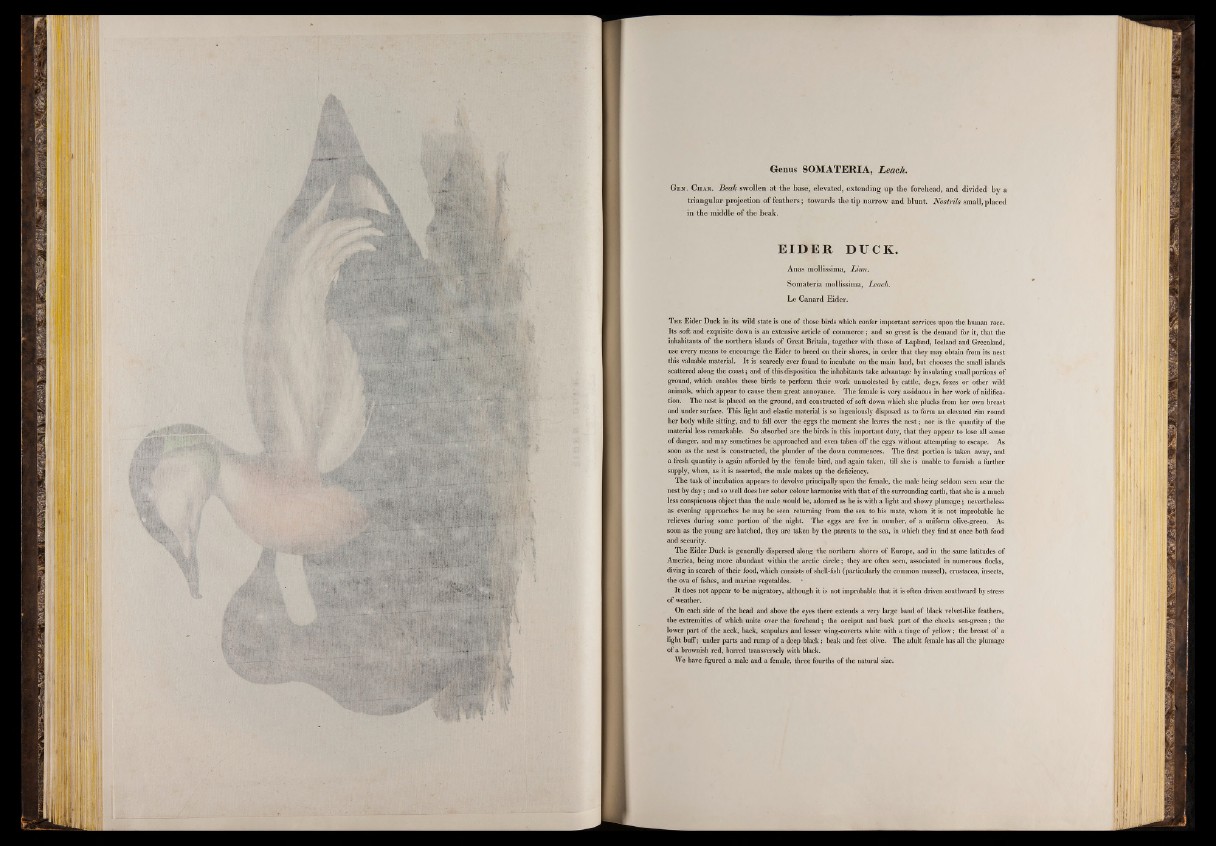
Genus SOMATERIA, Leach.
Gen. C h a r . B e a k swollen at the base, elevated, extending up the forehead, and divided by a
triangular projection o f feathers; towards the tip narrow and blunt. Nostrils small, placed
in the middle o f the beak.
E ID E R DUCK.
Anas mollissima, Linn.
Somateria mollissima, Leach.
Le Canard Eider.
T he Eider Duck in its wild state is one o f those birds which confer important services upon the human race.
Its soft and exquisite down is an extensive article of commerce; and so great is the demand for it, that the
inhabitants of the northern islands of Great Britain, together with those of Lapland, Iceland and Greenland,
use every means to encourage the Eider to breed on their shores, in order that they may obtain from its nest
this valuable material. It is scarcely ever found to incubate on the main land, but chooses the small islands
scattered along the coast; and of this disposition the inhabitants take advantage by insulating small portions of
ground, which enables these birds to perform their work unmolested by cattle, dogs, foxes or other wild
animals, which appear to cause them great annoyance. The female is very assiduous in her work of nidifica-
tion. The nest is placed on the ground, and constructed of soft down which she plucks from her own breast
and under surface. This light and elastic material is so ingeniously disposed as to form an elevated rim round
her body while sitting, and to fall over the eggs the moment she leaves the nest; nor is the quantity of the
material less remarkable. So absorbed are the birds in this important duty, that they appear to lose all sense
of danger, and may sometimes be approached and even taken off the eggs without attempting to escape. As
soon as the nest is constructed, the plunder of the down commences. The first portion is taken away, and
a fresh quantity is again afforded by the female bird, and again taken, till she is unable to furnish a further
supply, when, as it is asserted, the male makes up the deficiency.
The task of incubation appears to devolve principally upon the female, the male being seldom seen near the
nest by day; and so well does her sober colour harmonize with that of the surrounding earth, that she is a much
less conspicuous object than the male would be, adorned as he is with a light and showy plumage; nevertheless
as evening approaches he may be seen returning from the sea to his mate, whom it is not improbable he
relieves during some portion of the night. The eggs are five in number, of a uniform olive-green. As
soon as the young are hatched, they are taken by the parents to the sea, in which they find at once both food
and security.
The Eider Duck is generally dispersed along-the northern shores of Europe, and in the same latitudes of
America, being more abundant within the arctic circle; they are often seen, associated in numerous flocks,
diving in search of their food, which consists of shell-fish (particularly the common mussel), crustácea, insects,
the ova of fishes, and marine vegetables.
It does not appear to be migratory, although it is not improbable that it is often driven southward by stress
of weather.
On each side of the head and above the eyes there extends a very large band of black velvet-like feathers,
the extremities o f which unite over the forehead; the occiput and back part of the cheeks sea-green; the
lower part of the neck, hack, scapulars and lesser wing-coverts white with a tinge of yellow; the breast of a
light huff; under parts and rump of a deep black; beak and feet olive. The adult female has all the plumage
of a brownish red, barred transversely with black.
We have figured a male and a female, three fourths of the natural size.